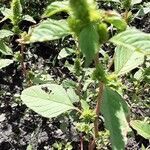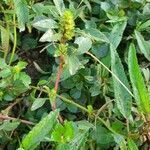Rather delicate mostly glabrous annuals to 1 m. high with ascending branches. Leaves glabrous or glabrate, entire or minutely crenulate, deltoid-to rhombic-ovate, apically rounded to acute, often mucronate, basally rounded to acute, 2-8 cm. long, 1-6 cm. broad; petioles 1-6 cm. long. Inflorescences of thyrses racemosely disposed, the terminal and axillary thyrses mostly cylindric and less than 6 mm. broad. Flowers polygamo-monoecious or monoecious; bracts and bracteoles sub-equal, lanceolate to ovate or obovate, acute to acuminate, 1.5-2 mm. long, the midribs dark green, the margins scariose; stamens discrete, 1-3 mm. long; ovary ovoid; styles (2-) 3, fimbrillate. Fruit a slightly rugose compressed ovoid utricle, circumscissile about the middle, 1.5-2.5 mm. long; seeds cochleate-orbiculate, reddish brown to black, reticulate, 0.8-1.1 mm. broad.
An annual herb plant. It is erect and grows up to 1.2 m tall. The stems are angular and the plant is often branched from the base upwards. Plants can be green or tinged purple. The leaves are 3-8 cm long by 2-5 cm wide. The leaf stalk is 1-5 cm long. Leaves can taper to a point at the tip and taper quickly towards the base. The flower clusters are in spikes on side branches and these can be branched. The flower stalks at the tip can be lax. The flower clusters can be 10-20 cm long and either stick upwards or bend over. Most of the flowers are female. Seed are 1-1.2 mm across and rather flat. Several types occur.


